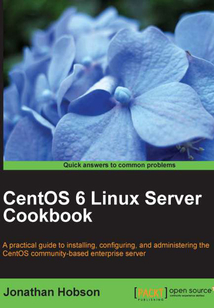舉報 

會員
CentOS 6 Linux Server Cookbook
最新章節:
Index
Thisbookiswrittenincookbookstyleanditofferslearningthroughrecipeswithexamplesandillustrations.Eachrecipecontainsstep-by-stepinstructionsabouteverythingnecessarytoexecuteaparticulartask.Thebookisdesignedsothatyoucanreaditfromstarttoendforbeginner'sorjustopenupanychapterandstartfollowingtherecipesasareferenceforadvancedusers,CentOS6LinuxServerCookbookisforLinuxprofessionalsandsystemadministratorsusingCentOSfortheirbusiness’sserver
目錄(105章)
倒序
- coverpage
- CentOS 6 Linux Server Cookbook
- Credits
- About the Author
- About the Reviewers
- www.PacktPub.com
- Support files eBooks discount offers and more
- Preface
- What this book covers
- What you need for this book
- Who this book is for
- Conventions
- Reader feedback
- Customer support
- Chapter 1. Installing CentOS
- Introduction
- Downloading CentOS and confirming the checksum on a Windows desktop
- Performing an installation of CentOS using the graphical installer
- Running a netinstall over HTTP
- Installing CentOS in Text Mode and building a minimal installation
- Re-installing the boot loader
- Updating the installation and enhancing the minimal install with additional administration and development tools
- Finishing the installation process with Firstboot
- Adding the GNOME desktop environment changing the runlevel and installing additional software
- Chapter 2. Configuring CentOS
- Introduction
- Changing the time zone and updating the hardware clock
- Synchronizing the system clock with NTP
- Setting a static IP address
- Binding multiple IP addresses to a single Ethernet device
- Bonding two Ethernet devices to increase bandwidth and provide redundancy
- Changing the hostname and resolving a fully qualified domain name
- Switching SELinux off
- Disabling the IPv6 module
- Chapter 3. Working with CentOS
- Introduction
- Creating an administrative user and becoming root with the switch user command
- Introducing mailx and forwarding the root's e-mail to an external e-mail address
- Automating tasks with cron
- Synchronizing files and directories with rsync and working towards a full system backup with cron
- Issuing customized e-mail reports with Mutt
- Using logrotate to manage logfiles
- Extending log rotation by adding NTP to logrotate
- Using chkconfig to enable a custom service at boot
- Evaluating current memory usage with the free and top commands and clearing the memory cache
- Chapter 4. Managing Packages with Yum
- Introduction
- Updating the system with YUM
- Cleaning the YUM cache
- Automating Yum updates with Yum-cron
- Installing packages with YUM
- Removing packages with YUM
- Finding packages with YUM
- Installing Yum Priorities to support additional repositories
- Enhancing CentOS with the EPEL and Remi repositories
- Chapter 5. Securing CentOS
- Introduction
- Escalating user privilege with sudo
- Hardening the secure shell environment
- Configuring a firewall and working with IPTables
- Protecting SSH with fail2ban
- Preventing dictionary-based attacks with DenyHosts
- Running antivirus scans with ClamAV
- Chapter 6. Working with Samba
- Introduction
- Configuring Samba as a standalone server and enabling home directories
- Adding deleting and disabling a Samba user
- Providing a network recycle bin for Samba
- Hiding folders and files with Samba
- Creating a custom share folder for a specific user or a group of users
- Chapter 7. Working with Domains
- Introduction
- Building a caching-only nameserver with BIND
- Writing zone files for BIND
- Adding zones to BIND and configuring a nameserver
- Deploying a local nameserver with dnsmasq
- Logging events with dnsmasq and combining this with logrotate
- Enabling domain name wildcards with dnsmasq
- Hardening BIND with chroot and providing better security measures
- Chapter 8. Working with Databases
- Introduction
- Installing and hardening MySQL server with mysql_secure_installation
- Creating a MySQL database adding a MySQL user and assigning user privilege from the command line
- Installing PostgreSQL adding a user and creating your first database
- Configuring remote access to PostgreSQL
- Chapter 9. Providing Mail Services
- Introduction
- Enabling a domain-wide Mail Transport Agent (MTA) and testing your SMTP configuration with Telnet
- Building a local POP3/SMTP server with Postfix and Dovecot
- Closing the open relay enabling SMTP authentication and dealing with Spam by configuring SASL and enabling Postfix header and body checks
- Using Postfix and Dovecot to serve e-mails across virtual domains
- Chapter 10. Working with Apache
- Introduction
- Installing the Apache web server with CGI/Perl PHP configuring mod_perl and preparing httpd for a production environment
- Adding a secure connection to the Apache web server by creating a self-signed SSL certificate using OpenSSL
- Hosting peers by enabling user directories on the Apache web server and troubleshooting suexec
- Configuring Apache name-based virtual hosting
- Working with publishing directories vhosts.d error documents directives and the rewrite rule for virtual hosting with the Apache web server
- Chapter 11. Working with FTP
- Introduction
- Building a basic FTP service by installing and configuring VSFTP
- Providing a secure connection to VSFTP with SSL/TLS using OpenSSL encryption
- Implementing virtual users and directories in standalone mode on VSFTP
- Providing an anonymous upload and download or download only FTP server with VSFTP
- Index 更新時間:2021-07-27 18:01:50
推薦閱讀
- Linux運維之道(第3版)
- Linux設備驅動開發詳解(第2版)
- Ganglia系統監控
- Ceph分布式存儲實戰
- Linux命令行大全(第2版)
- Social Data Visualization with HTML5 and JavaScript
- Windows 7使用詳解(修訂版)
- Linux軟件管理平臺設計與實現
- 從實踐中學習Windows滲透測試
- Learn Quantum Computing with Python and IBM Quantum Experience
- Hadoop Operations and Cluster Management Cookbook
- Windows Azure實戰
- Getting Started with Citrix XenApp 6.5
- 鴻蒙應用開發實戰
- Windows8應用開發權威指南
- 構建高可用Linux服務器
- 電腦辦公(Windows 10+Office 2016)從入門到精通
- SolidWorks 2014中文版機械設計從入門到精通
- Docker on Windows
- Creating templates with Artisteer
- 跟老男孩學Linux運維:高性能Web集群實踐(上)
- Oracle JET for Developers
- Getting Started with Citrix? CloudPortal?
- Windows PowerShell實戰指南(第3版)
- Architecting Cloud Native Applications
- Ceph企業級分布式存儲:原理與工程實踐
- Concurrent Patterns and Best Practices
- DevOps for Serverless Applications
- Getting Started with Oracle VM VirtualBox
- Android底層開發實戰

